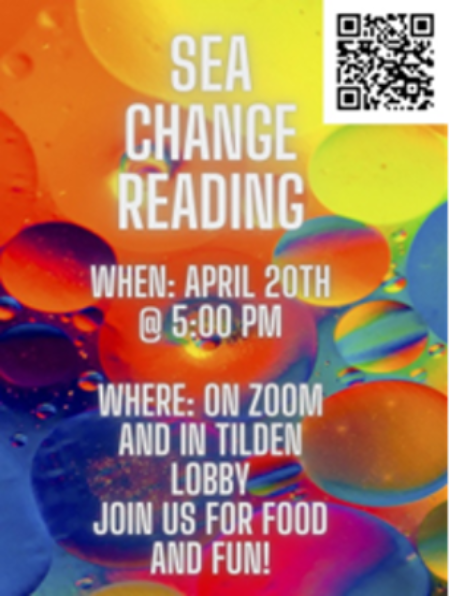This Year’s Sea Change Reading Promises to be Gifted and Groovy
by Olivia Williams
Along with the other members of his Sea Change class, Dylan Girouard spent most of his semester sifting through submissions of art, poetry, and non-fiction submissions to the art and literary magazine. When pressed for an exact count, he said that there were 110 art submissions, 35 poetry submissions, and 14 non-fiction and fiction submissions. Girouard is part of the Sea Change publication, a yearly magazine that is created in a class offered every spring. The magazine accepts written work as well as art from all students throughout the year, though a submissions campaign is held at the beginning of the year. The class culminates in a reading and art show. This year’s show will be held at the Tilden Arts Center Lobby, with an accompanying Zoom link, at 5 p.m. April 20.

It’s an especially exciting show for Girouard and his classmates; they hope it will be “more of a personal, intimate-feeling, positive, cool, low-key poetry reading.” Their hopes are strengthened by the fact that the reading will be a hybrid one, with a Zoom link and live readings among easels and PowerPoint presentations that will feature the art.
This year focuses on a 1970s theme. In their design proposals given at the beginning of the year, “all of us had the ‘70s theme in mind,” says Girouard. The drastic events currently happening in the world – Girouard especially cited George Floyd and the Black Lives Matter movement, as well as the volatile economy– mirror some of the turning points of the 1970s, and the class wanted to pay homage to that.
“All I’ll say is there’s a very strong, groovy, psychedelic, eye-catching, color-pop feel,” says Girouard.
It is Girouard’s second year working with the Sea Change publication, and he is the lead copy editor with Eleanor Gubbins, both of whom work underneath Sam White, who is the editor-in-chief. Girouard describes the piece selection as a “rigorous process.” The team ultimately ended up picking 20 to 25 art submissions, 10 or so poetry submissions, and about half, or seven, of the long-form pieces, which Girouard says are more “difficult to select” because they are “lengthier” and the class wanted to “cram in as much as possible.”
“It’s a really nice introduction to publication and qualifying work,” says Girouard, who knows of at least two students who have gotten jobs in the publishing industry because of their work on the magazine. He himself is planning to transfer to the University of Massachusetts Amherst as an English major.
He cites compromise as the main lesson Sea Change has taught him. Each participant in the “tight-knit” class must rate the submissions for homework, which are then used in the selection for publication. The classes, which range from 6 to 10 students per semester, don’t always agree. Ultimately, however, the spirit of collaboration, compromise, and creativity in the class is valued.
“Towards the end, you really build strong relationships,” says Girouard.
Sea Change is a class that he would “highly recommend to any students at 4C’s.” He says it has taught him many valuable lessons about the art and its interpretation.
“When you have an art piece next to a poem, they communicate and speak to one another,” Girouard says, “and you have to be mindful of that.”
Having the pieces displayed in person will facilitate these conversations, and Girouard sees the Sea Change show as a “step forward in terms of showcasing student art and writing.”
This year’s publication can also be found, with previous years, at https://seachangecapecod.wordpress.com/. The link to the virtual viewing on April 20 is https://capecod.zoom.us/j/96695236493.
Categories: Featured, Arts & Entertainment, Events